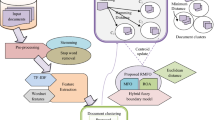Abstract
With the rapid growth of text documents, document clustering technique is emerging for efficient document retrieval and better document browsing. Recently, some methods had been proposed to resolve the problems of high dimensionality, scalability, accuracy, and meaningful cluster labels by using frequent itemsets derived from association rule mining for clustering documents. In order to improve the quality of document clustering results, we propose an effective Fuzzy Frequent Itemset-based Document Clustering (F2IDC) approach that combines fuzzy association rule mining with the background knowledge embedded in WordNet. A term hierarchy generated from WordNet is applied to discover generalized frequent itemsets as candidate cluster labels for grouping documents. We have conducted experiments to evaluate our approach on Classic4, Re0, R8, and WebKB datasets. Our experimental results show that our proposed approach indeed provide more accurate clustering results than prior influential clustering methods presented in recent literature.
Similar content being viewed by others
References
Agrawal R, Imielinski T, Swami AN (1993) Mining association rules between sets of items in large databases. In: ACM SIGMOD international conference on management of data, pp 207–216
Beil F, Ester M, Xu X (2002) Frequent term-based text clustering. In: International conference on knowledge discovery and data mining (KDD’02), pp 436–442
Chen CL, Tseng FSC, Liang T (2008) Hierarchical document clustering using fuzzy association rule mining. In: The 3rd international conference of innovative computing information and control (ICICIC2008), pp 326–330
Chen CL, Tseng FSC, Liang T (2010) Mining fuzzy frequent itemsets for hierarchical document clustering. Inf Process Manag 46(2): 193–211
Craven M, DiPasquo D, McCallum A, Mitchell T, Nigam K, Slattery S (1998) Learning to extract symbolic knowledge from the World Wide Web. In: AAAI-98
Cutting DR, Karger DR, Pederson JO, Tukey JW (1992) Scatter/gather: a cluster-based approach to browsing large document collections. In: The 15th international ACM SIGIR conference on research and development in information retrieval, pp 318–329
Exarchos TP, Tsipouras MG, Papaloukas C, Fotiadis DI (2009) An optimized sequential pattern matching methodology for sequence classification. Knowl Inf Syst 19(2): 249–264
Fung B, Wang K, Ester M (2003) Hierarchical document clustering using frequent itemsets. In: SIAM international conference on data mining (SDM’03), pp 59–70
Hong TP, Lin KY, Wang SL (2003) Fuzzy data mining for interesting generalized association rules. Fuzzy Sets Syst 138(2): 255–269
Hotho A, Staab S, Stumme G (2003) Wordnet improves text document clustering. In: SIGIR international conference on Semantic Web Workshop
Huang Z, Sun S, Wang W (2010) Efficient mining of skyline objects in subspaces over data streams. Knowl Inf Syst 22(2): 159–183
Kaya M, Alhajj R (2006) Utilizing genetic algorithms to optimize membership functions for fuzzy weighted association rule mining. Appl Intell 24(1): 7–15
Kushal Dave DMP, Lawrence S (2003) Mining the peanut gallery: opinion extraction and semantic classification of product reviews. In: The 12th international conference on World Wide Web (WWW)
Lewis DD, Yang Y, Rose TG, Li F (2004) RCV1: a new benchmark collection for text categorization research. J Mach Learn Res 5: 361–397
Liu B, Hsu W, Ma Y (1999) Pruning and summarizing the discovered associations. In: The ACM SIGKDD conference on knowledge discovery and data mining, pp 125–134
MacQueen JB (1967) Some methods for classification and analysis of multivariate observations. In: The 5th Berkeley Symposium on Mathematical Statistics and Probability, pp 281–297
Mandhani B, Joshi S, Kummamuru K (2003) A matrix density based algorithm to hierarchically co-cluster documents and words. In: The 12th international conference on World Wide Web (WWW), pp 511–518
Martín-Bautista MJ, Sánchez D, Chamorro-Martínez J, Serrano JM, Vila MA (2004) Mining web documents to find additional query terms using fuzzy association rules. Fuzzy Sets Syst 148(1): 85–104
Michenerand CD, Sokal RR (1957) A quantitative approach to a problem in classification. Evolution 11: 130–162
Miller GA (1995) WordNet: a lexical database for English. J Commun ACM 38(11): 39–41
Porter MF (1980) An algorithm for suffix stripping. Program 14(3): 130–137
Scott S, Matwin S (1998) Text classification using WordNet hypernyms. In: Proceedings of Worksh Usage of WordNet in NLP Systems at COLING-98, pp 38–44
Sedding J, Kazakov D (2004) WordNet-based text document clustering. In: COLING-2004 workshop on robust methods in analysis of natural language data
Shihab K (2004) Improving clustering performance by using feature selection and extraction techniques. J Intell Syst 13(3): 135–161
Singhal A, Salton G (1993) Automatic text browsing using vector space model. Technical Report, Department of Computer Science, Cornell University
Steinbach M, Karypis G, Kumar V (2000) A comparison of document clustering techniques. In: The 6th ACM SIGKDD international conference on knowledge discovery and data mining (KDD)
Wang P, Hu J, Zeng H-J, Chen Z (2009) Wikipedia knowledge to improve text classification. Knowl Inf Syst 19(3): 265–281
Wei C, Hu P, Dong YX (2002) Managing document categories in e-commerce environments: an evolution-based approach. Eur J Inf Syst 11(3): 208–222
Willett P (1988) Recent trends in hierarchic document clustering: a critical review. Inf Process Manag 24(5): 577–597
Xu W, Gong Y (2004) Document clustering by concept factorization. In: The 27th ACM SIGIR conference on research and development in information retrieval, pp 202–209
Yu H, Searsmith D, Li X, Han J (2004) Scalable construction of topic directory with nonparametric closed termset mining. In: The IEEE international conference on data mining series (ICDM 2004), pp 563–566
Zadeh LA (1965) Fuzzy sets. Inf Control 8: 338–353
Author information
Authors and Affiliations
Corresponding author
Rights and permissions
About this article
Cite this article
Chen, CL., Tseng, F.S.C. & Liang, T. An integration of fuzzy association rules and WordNet for document clustering. Knowl Inf Syst 28, 687–708 (2011). https://doi.org/10.1007/s10115-010-0364-2
Received:
Revised:
Accepted:
Published:
Issue Date:
DOI: https://doi.org/10.1007/s10115-010-0364-2




